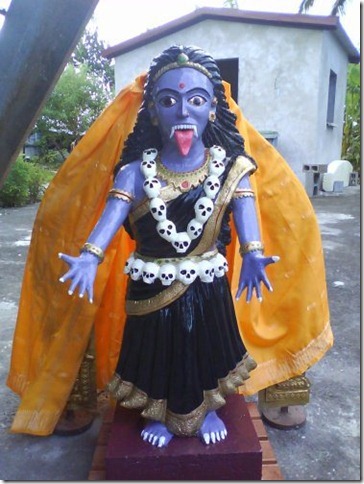The word Kali has two meanings. One meaning is dark and the other is the feminine of Kala (time). Generally in Hinduism, particularly in the Sakta religion, Kali is the name of the goddess. There are actually more than 1 Kali.
Kali is one of the 7 Matrika devis which are actually the Sakti (power) of individual deities. They are worshipped as virgin devis and they are not consorts of the associated deities.
Brahmi (power of Brahma)
Maheswari (power of Maheswara)
Kaumari (power of Kumara Muruga)
Vaishnavi (power of Vishnu)
Varahi (power of Varaha or Yama)
Mahendri (power of Indra)
Chamunda (power of Durga)
Varahi is an interesting deity to be studied as she also exist in Buddhism as VajraVarahi. She is associated with both Varaha (Vishnu) and Yama. Although she is sow faced (VarahaMukhi), her attributes are associated with the lord of death. She has many forms but the most commonly worshipped form is the one with a buffalo as vahana. As the power of Yama, she is often associated with death and longetivity. Hence the sloka Ayur Rakshatu Varahi (may Varahi protect my life).
The Durga Sapthasathi mentions Chamunda as being originally called as Kali, the dark one. Kali which was created from the wrath of MahaDurga kills Chanda and Munda. From then on, she is called Chamunda. It is this Chamunda who we worship as Chamundi, Chamundeshwari, Chamundiamman. Since she was the youngest of the Matrikas, she is called as Chelli in rural Tamil Nadu. This is how we get other names like Chelliamman, Chellayee and Chellatha.
Therefore, this particular Kali is a matrika which is seen as the source of MahaDurga's power. She sits on a corpse and guards all 10 directions.
Evam Dasa Disa Rakshe Chamunda Sava Vahana
The other Kali is MahaKali or AdiParasakti herself in her glorious form as ParaBrahma. This is what we worship as MahaDurga in the Durga Sapthasathi or Devi Mahatmyam. As ParaBrahma in Sarguna form, MahaDurga has three main aspects:
MahaKali, she awakened MahaVishnu to kill Madhu and Kaitabha
MahaLakshmi, she is also known as MahishaSuraMardhini
MahaSaraswathi, she is also known as NisumbhaSoodhani
Again, these three forms are not consorts of the Tirumurti; Parvathi, Lakshmi, Saraswathi. They are three aspects of the same ParaBrahma as per the ChandiVidya tradition of the Sakta religion. As per the SriVidya tradition, ParaBrahma is in the form of Kamesvari or LalitaTripuraSundari. Both traditions refer to the same ParaBrahma in different female forms.
Hrdaye LalitaDevi, Uddhare SoolaDharini (from ChandiKavacham)
Durlabha Durgama Durga Dukhahantri Sukhaprada (from Lalita Sahasranamam)
MahaKali also exist as one of the DasaMahaVidya.
The word Kali is also used in reference to other female deities who are the expansion of the original Kali (Chamunda) or MahaKali (Parasakti). You may come across names like SmashnaKali, MayanaKali, RudraKali, DakshinaKali, BadraKali, GuhyaKali, UchistaKali and many others.
Kali worship is popular in the Bengal region, where Tantra is the dominant Hindu scripture. It is also popular among other Indians particularly in the rural areas. Many of the Kali shrines includes spirit worship. They include rituals that involves trance. They add the suffix Kali and call the deity as Kali but it is not necessarily the actual Kali herself. Usually it is Her attendants which are being propitiated under her banner.
 |
| Katteri statue. PIC CREDIT richardarunachala |
Another spirit worship which is peculiar to the Tamils is the worship of Katteri. There is a grave misinformation in the internet where Katteri is being called Katyayani. I also noticed that some Hindus in the Caribbean worship Katteri as Kalratri by using the statue of Kalratri.
It is fine to worship Kalratri or Katyayani but both are not Katteri spirits. They are actually MahaDurga herself. In the Sakta religion, Durga can be worshiped as NavaDurga (9 Durgas). There are two main version of NavaDurgas.
The Puranic version - Sailaputri, Brahmacharini, Chandraganta, Kushmanda, Skandamata, Katyayani, Kalratri, Mahagauri and Siddhidatri.
The Agamic version - VanaDurga, SooliniDurga, JatavedaDurga, ShantiDurga, SabariDurga, JvalaDurga, LavanaDurga, DeepaDurga and AsuriDurga (some includes KanagaDurga and JayaDurga)
The Tamil Hindus often add the suffix Amman (mother goddess) whenever it involves a female deity. This includes spirits and beings like Yakshis i.e Isakkiyamman. So Katteri becomes Katteriamman although she may not necessarily be a benevolent amman.
Katteris are malevolent spirits which are found in the Kaadu (forest) and Eri (Lake), hence the name Katteri (Kaadu + Eri). The word Katteri also refers to vampires in the Tamil society. In fact, rural folks often call these spirits as RattaKatteri (blood vampires) and they don't have a good reputation among the masses.
Over time, some Katteris were worshiped as family deities. If there were some form of mutual agreement between a person (especially an ancestor) and a Katteri, i.e person agreed to give offering so that in return the Kateri does not cause mischief or should provide protection from other malevolent spirits, then this can also happen.
Therefore, I hope that the difference between Kali, MahaKali (Durga) and Katteri is now clearer.





thank you!!
ReplyDeleteThe part about காடேரி அம்மன் (Kaderi Amman) can’t be right. My father’s குல தெய்வம் is Kaderi Amman but there is no sign of malevolent spirit’s influence or “bad vibrations”.
ReplyDeleteI won’t say for certain but it’s my general assumption because the picture of that Amman who’s my Father’s kula Deivam is also in my family prayer room and there is no hint of any adverse ominous vibrations in there at all.